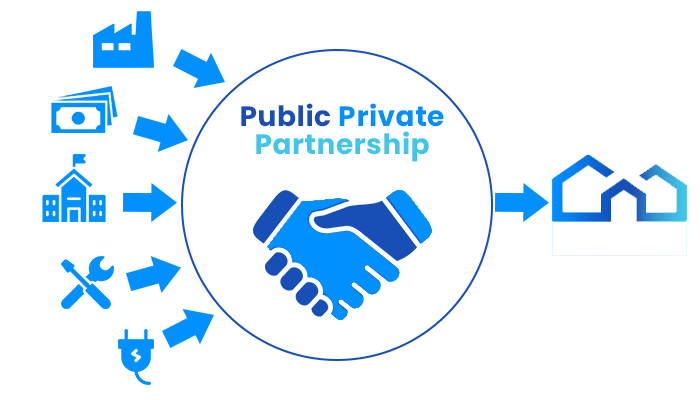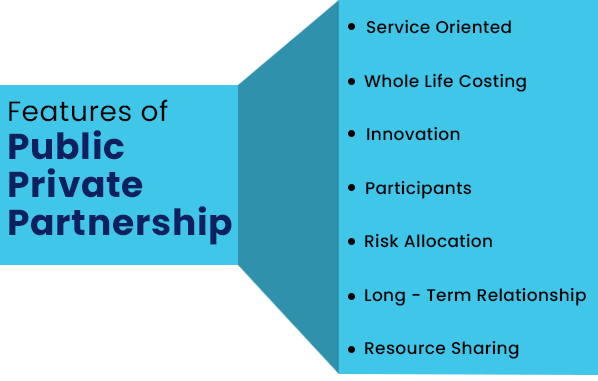What is the full form of PPPPPP: Public Private PartnershipPPP stands for Public-Private Partnership. It refers to a long-term arrangement between public and private sectors, for delivering those projects and services traditionally delivered by the public sector. 
The public-private partnership helps to enhance the outcome of any services by increasing efficiency, competitiveness and quality of public services. When proper cooperation is taking place between the public and private sectors, it creates a better value for taxpayers by providing good management skills with the help of the private sector. In budgetary deficit, the public-private partnership helps to increase finance and support the public sector's limited capacities. The public-private partnership can speed up infrastructure developments throughout the country by efficiently and qualitatively delivery of services. Public-Private Partnership ModelUnder this model private sector financed government projects & services and earned its profits from users and taxpayers. The public-private partnership is used or implemented throughout the World. It is used for various infrastructure and development projects in multiple countries. Its main purpose is to deliver services efficiently by employing, maintaining, operating, building, and equipping all social infrastructure such as schools, hospitals, and general infrastructures such as roads, transport systems, water, and sewerage systems. Its representation is marked by the shaking of hands between the public sector and the private sector. It is not a new concept. Its origin is traceable from the existence of early states when the government came in contact with the private sector for tax collection, colonization, trade and infrastructure developments. However, the present and contemporary public-private partnerships are associated with the neoliberal policies of the Modern World and developed around the end of the 20th century. Neoliberal policies are meant to enhance the private sector's role in delivering services, public administration, etc. At the start of this concept, the government saw this partnership as a tool to finance the new and renovate the older projects outside their balance sheet. Some of the most common forms used in a public-private partnership are build-operate-transfer (BOT), Operate transfer (OMT), Build lease transfer (BLT) etc. The main feature of the public-private partnership is that the private sector takes major risks. Advantages of Public-Private Partnership
1. Easy Access to Private Finance:Developing countries like India, Brazil, Indonesia etc., has very large social and general infrastructure need, and these infrastructure projects have associated funding gap here. Public-private partnership plays an important role by providing required finance to fill the funding gap or meet infrastructure needs. When the private sector started providing the required finance for any project, this released the public sector from meeting the financial requirements of projects which it pays through revenues, taxes or borrowing. 2. Superior Infrastructure:Sometimes, it has been seen that fully private project have more financial requirements because it tries to provide superior infrastructure, making the project costly. On the other hand, public sector projects suffer from various lacunas, and this public-private partnership provides affordable, accessible solutions or alternatives to a wholly public or wholly private project. Under this type of cooperation, responsibility is shared between both sectors, and they provide a high quality of infrastructure to the public in an affordable, accessible manner. 3. Transparency:A public-private partnership agreement brings transparency in utilizing funds. It means the financial amount is in the public domain, so people can easily access this information, leading to the transparent working of the private and public sectors. The allotment of projects under the public-private partnership is done through the tender under this project. It is allotted to the highest bidder based on competitive bidding following best practices and procedures, which are appreciated all over the World. 4. Minimum delay:Projects allowed under public-private partnership have to be completed in time bound manner because projects are allowed for a certain period. This result in the faster completion of projects. This type of cooperation minimises the delays of various infrastructure completion because the completion of projects is taken as the parameters of performance and profits. 5. Distribution of risk between the public and private sector:The main advantage of PPP is the distribution of risk between the government and the private sector. Under this, most of the risk is held by the private sector as they finance the project at the initial stage of project development. Still, the private sector is taken as an opportunity to explore all the benefits attached to the project and raise their profit margins. 6. Regular flow of cash:When the central budget is formed, each Ministry in the central allotted funds according to their needs and requirements, and the amount allowed is fixed. But often, projects need more money for completion than allowed, so projects suffer from a budgetary deficit. Therefore, to solve this problem, public-private partnership plays an important role by providing a constant cash flow when needed and completing projects in time bound manner. Disadvantages of Public-Private Partnership1. Uncertainty in Project Completion:Under a Public-private partnership, the project allowed for longer durations and was completed mostly in 15-20 years. Projects which take a longer time for completion are at the greatest risk of uncertainty. Any changes in the funding, administration, and processing of projects their effects are also seen in the development of projects; sometimes, projects are modified fully to reflect desirable changes and this increase the time of project completion. And this increases the overall project cost and creates an additional burden on the public. 2. Coordination Gaps:Projects under public-private partnerships suffer from various lacunas, most importantly, inadequate and inefficient regulatory frameworks. And it considers a serious setback for project developers and contractors. Many projects would suffer from necessary clearance even if they completed their documentation wholly because there is a lack of coordination among various ministries, such as the Ministry of environment for environmental clearance and various other such ministries. 3. Crony Capitalism:Under this success of a business depends upon the mutual relationship between the government officials and the business people. The nexus between the political class characterise government officials and the business class. This concept is marked by the favouritism the government shows towards particular businesses by granting tax breaks, allocating certain legal permits to specific individuals or businesses, and pro-business policy supporting only some specific business development. In public-private partnerships, people sometimes use their money or muscle power to contract by forming nexus with political leaders. 4. Expensive Project:The private sector invests money in projects under the public-private partnership. They have to deliver a project of the best quality for delivering the best project, and they undertake lots of risk by investing more and more, for they employ those people who are best in their jobs. They charge a huge salary for this, which automatically raises the cost of the projects. 5. Fewer Jobs in the Public sector:When the private sector acquires any project, they employ their workforce. And by decreasing the government role, they perform most of the work and this creates employment opportunities in the private sector. It creates a downfall in the employment of the public sector because the role and the responsibility played by the public sector decreases. 6. Division of Profits:Under this type of cooperation, the public sector has to share the profits with the private sector because of private sector investment in the projects. After the completion of projects, they charge high prices for the delivery of services.
Next TopicFull Form
|
 For Videos Join Our Youtube Channel: Join Now
For Videos Join Our Youtube Channel: Join Now
Feedback
- Send your Feedback to [email protected]
Help Others, Please Share










